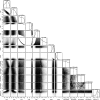Io's tidal response precludes a shallow magma ocean
- PMID: 39667409
- PMCID: PMC11798835
- DOI: 10.1038/s41586-024-08442-5
Io's tidal response precludes a shallow magma ocean
Abstract
Io experiences tidal deformation as a result of its eccentric orbit around Jupiter, which provides a primary energy source for Io's continuing volcanic activity and infrared emission1. The amount of tidal energy dissipated within Io is enormous and has been suggested to support the large-scale melting of its interior and the formation of a global subsurface magma ocean. If Io has a shallow global magma ocean, its tidal deformation would be much larger than in the case of a more rigid, mostly solid interior2. Here we report the measurement of Io's tidal deformation, quantified by the gravitational tidal Love number k2, enabled by two recent flybys of the Juno spacecraft. By combining Juno3,4 and Galileo5-7 Doppler data from the NASA Deep Space Network and astrometric observations, we recover Re(k2) of 0.125 ± 0.047 (1σ) and the tidal dissipation parameter Q of 11.4 ± 3.6 (1σ). These measurements confirm that a shallow global magma ocean in Io does not exist and are consistent with Io having a mostly solid mantle2. Our results indicate that tidal forces do not universally create global magma oceans, which may be prevented from forming owing to rapid melt ascent, intrusion and eruption8,9, so even strong tidal heating-such as that expected on several known exoplanets and super-Earths10-may not guarantee the formation of magma oceans on moons or planetary bodies.
© 2024. The Author(s).
Conflict of interest statement
Competing interests: The authors declare no competing interests.
Figures









References
-
- Peale, S. J., Cassen, P. & Reynolds, R. T. Melting of Io by tidal dissipation. Science203, 892–894 (1979). - PubMed
-
- Bierson, C. J. & Nimmo, F. A test for Io’s magma ocean: modeling tidal dissipation with a partially molten mantle. J. Geophys. Res. Planets121, 2211–2224 (2016).
-
- Folkner, W. M. et al. Jupiter gravity field estimated from the first two Juno orbits. Geophys. Res. Lett.44, 4694–4700 (2017).
-
- Iess, L. et al. Measurement of Jupiter’s asymmetric gravity field. Nature555, 220–222 (2018). - PubMed
-
- Anderson, J. D., Jacobson, R. A., Lau, E. L., Moore, W. B. & Schubert, G. Io’s gravity field and interior structure. J. Geophys. Res. Planets106, 32963–32969 (2001).

